Identifying osteoporotic vertebral fracture
- PMID: 26435923
- PMCID: PMC4559972
- DOI: 10.3978/j.issn.2223-4292.2015.08.01
Identifying osteoporotic vertebral fracture
Abstract
Osteoporosis per se is not a harmful disease. It is the sequela of osteoporosis and most particularly the occurrence of osteoporotic fracture that makes osteoporosis a serious medical condition. All of the preventative measures, investigations, treatment and research into osteoporosis have one primary goal and that is to prevent the occurrence of osteoporotic fracture. Vertebral fracture is by far and away the most prevalent osteoporotic fracture. The significance and diagnosis of vertebral fracture are discussed in this article.
Keywords: Vertebral fracture; computed tomography (CT); magnetic resonance imaging (MRI); metastases; osteoporosis; radiography.
Conflict of interest statement
Figures


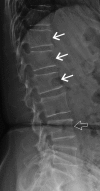
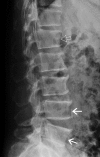
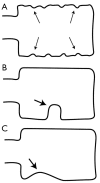
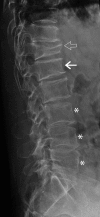
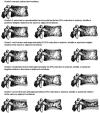
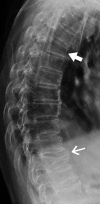
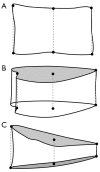

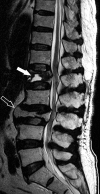
Similar articles
-
Pain precedes computer axial tomography and scintigraphic findings in an osteoporotic vertebral compression fracture: a case report.Pain Med. 2008 Oct;9(7):866-70. doi: 10.1111/j.1526-4637.2008.00479.x. Epub 2008 Jul 24. Pain Med. 2008. PMID: 18657221
-
When should the doctor order a spine X-ray? Identifying vertebral fractures for osteoporosis care: results from the European Prospective Osteoporosis Study (EPOS).J Bone Miner Res. 2004 Dec;19(12):1982-93. doi: 10.1359/JBMR.040901. Epub 2004 Sep 7. J Bone Miner Res. 2004. PMID: 15537441
-
Recognizing and reporting vertebral fractures: reducing the risk of future osteoporotic fractures.Can Assoc Radiol J. 2007 Feb;58(1):27-36. Can Assoc Radiol J. 2007. PMID: 17408160
-
[Large clinical trials for osteoporosis].Therapie. 2003 Sep-Oct;58(5):415-20. doi: 10.2515/therapie:2003067. Therapie. 2003. PMID: 14682189 Review. French.
-
Atraumatic vertebral compression fractures: differential diagnosis between benign osteoporotic and malignant fractures by MRI.Musculoskelet Surg. 2013 Aug;97 Suppl 2:S169-79. doi: 10.1007/s12306-013-0277-9. Epub 2013 Aug 15. Musculoskelet Surg. 2013. PMID: 23949939 Review.
Cited by
-
Development and usability of a decision aid to initiate anti-osteoporosis medication treatment in patients visiting the fracture liaison service with a recent fracture.Osteoporos Int. 2024 Jan;35(1):69-79. doi: 10.1007/s00198-023-06906-4. Epub 2023 Sep 21. Osteoporos Int. 2024. PMID: 37733067 Free PMC article.
-
Nature-Inspired Unconventional Approaches to Develop 3D Bioceramic Scaffolds with Enhanced Regenerative Ability.Biomedicines. 2021 Jul 29;9(8):916. doi: 10.3390/biomedicines9080916. Biomedicines. 2021. PMID: 34440120 Free PMC article. Review.
-
Acute vertebral fracture after spinal fusion: a case report illustrating the added value of single-source dual-energy computed tomography to magnetic resonance imaging in a patient with spinal Instrumentation.Skeletal Radiol. 2016 Sep;45(9):1303-6. doi: 10.1007/s00256-016-2419-2. Epub 2016 Jun 7. Skeletal Radiol. 2016. PMID: 27270922
-
The association between remnant cholesterol and the risk of osteoporotic vertebral fracture in older adults.PLoS One. 2025 Jul 29;20(7):e0327171. doi: 10.1371/journal.pone.0327171. eCollection 2025. PLoS One. 2025. PMID: 40729345 Free PMC article.
-
Osteoporosis Imaging in the Geriatric Patient.Curr Radiol Rep. 2016 Apr;4(4):18. doi: 10.1007/s40134-016-0144-1. Epub 2016 Feb 15. Curr Radiol Rep. 2016. PMID: 27482472 Free PMC article.
References
-
- Cooper C, Atkinson EJ, O'Fallon WM, Melton LJ, 3rd. Incidence of clinically diagnosed vertebral fractures: a population-based study in Rochester, Minnesota, 1985-1989. J Bone Miner Res 1992;7:221-7. - PubMed
-
- Lips P, van Schoor NM. Quality of life in patients with osteoporosis. Osteoporos Int 2005;16:447-55. - PubMed
-
- Kado DM, Browner WS, Palermo L, Nevitt MC, Genant HK, Cummings SR. Vertebral fractures and mortality in older women: a prospective study. Study of Osteoporotic Fractures Research Group. Arch Intern Med 1999;159:1215-20. - PubMed
-
- Siris ES, Miller PD, Barrett-Connor E, Faulkner KG, Wehren LE, Abbott TA, Berger ML, Santora AC, Sherwood LM. Identification and fracture outcomes of undiagnosed low bone mineral density in postmenopausal women: results from the National Osteoporosis Risk Assessment. JAMA 2001;286:2815-22. - PubMed
Publication types
LinkOut - more resources
Full Text Sources
